Introduction
In the pursuit of a healthier lifestyle and enhanced athletic performance, understanding the significance of the oblique muscles cannot be overstated. These essential muscles, located on the sides of the abdomen, play a pivotal role in core stability, functional movement, and injury prevention.
As organizations seek to prioritize the well-being of their teams, integrating effective oblique workouts into fitness initiatives emerges as a powerful strategy. From targeted exercises that sculpt the obliques to the importance of balancing strength and flexibility, this article delves into the anatomy and function of these muscles, providing practical insights for HR Benefits Managers eager to cultivate a robust and resilient workforce.
By embracing comprehensive training plans, individuals not only improve their physical appearance but also foster a culture of wellness that can lead to enhanced performance and reduced injury rates.
Understanding the Oblique Muscles: Anatomy and Function
The ripped obliques, which are the slanted muscles located on the sides of your abdomen, are essential for both core stability and functional movement. Comprised of two primary groups, the external muscles facilitate trunk rotation and lateral flexion, while the internal muscles contribute to these movements and provide essential support to the spine. Strengthening the ripped obliques not only enhances physical appearance but also significantly improves balance and lowers the risk of accidents during sports and physical activities.
According to the narrative review by Nealon et al., comprehending the mechanics of side strain and the function of lateral muscles in preventing harm is essential for athletes. As Dr. Angela M. Bell, MD, FACP, states,
Unexplained muscle pain may be due to injury or overuse.
Additionally, Shin-ichi Konno emphasizes the importance of addressing angled muscle strains, which are particularly relevant given that lower abdominal pain syndrome has been reported in NHL players, as noted in Clin J Sports Med.
This emphasizes the necessity of concentrating on angled workouts, as recent studies indicate that targeted training can enhance core stability and help develop ripped obliques, leading to better athletic performance. Real-world examples, such as the 2022 study on Japanese baseball players, demonstrate that those who participated in effective angled training recovered successfully from strains and returned to play. Embracing these insights will inspire you to integrate comprehensive angled workouts into your routine, ultimately fostering a healthier, more resilient team.
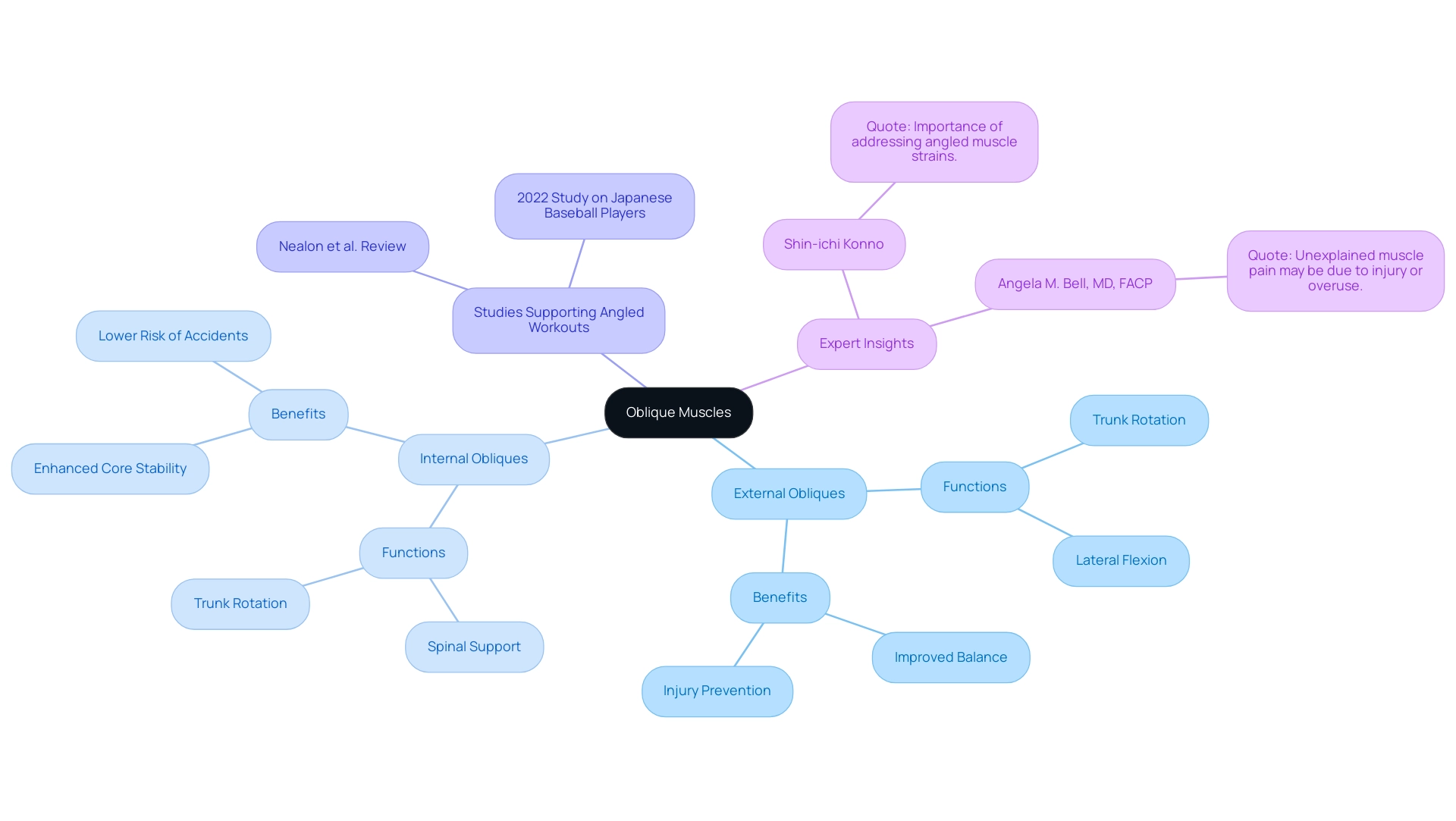
Top Exercises for Sculpting Ripped Obliques
-
Russian Twists: Begin by sitting on the floor with your knees bent and lean back slightly. Grasp a weight or medicine ball, and rotate your torso from side to side, engaging your core throughout the movement. Aim for 2 to 3 sets of 8 to 16 repetitions. This activity is not only effective for sculpting your ripped obliques but also allows for variations to increase difficulty without sacrificing form. As a fitness expert noted,
You are producing some abdominal tension … but you are also generating compression, flexion and rotation on the disc … It’s just not worth the risk.
Emphasizing the importance of maintaining proper form will maximize results while minimizing injury risk. Furthermore, integrating variations, as emphasized in the case study named 'Russian Twist Variations,' can assist athletes in progressively improving their abdominal strength and adjusting the activity to their fitness levels.
-
Side Plank: Position yourself on your side and lift your body off the ground, supporting your weight on your forearm. Hold this position for 30-60 seconds on each side. The side plank is a powerhouse movement that fortifies the entire midsection, with a specific emphasis on the side muscles. Adding this activity to your routine can result in significant enhancements in stability.
-
Bicycle Crunches: Lie on your back and lift your legs into a tabletop position. Alternate bringing your elbow to the opposite knee while extending the other leg, ensuring a controlled movement. Perform 3 sets of 15-20 repetitions. This energetic activity effectively activates your side muscles and offers a thorough abdominal workout.
-
Woodchoppers: Stand with your feet shoulder-width apart, holding a weight at shoulder height. Rotate your torso to bring the weight down towards the opposite hip, mimicking a chopping motion. Perform 3 sets of 10-15 repetitions on each side. This exercise not only targets your ripped obliques but also enhances overall core strength.
Incorporating these exercises into your routine can significantly sculpt your ripped obliques and elevate your core strength, empowering you to prioritize team well-being through effective fitness initiatives.
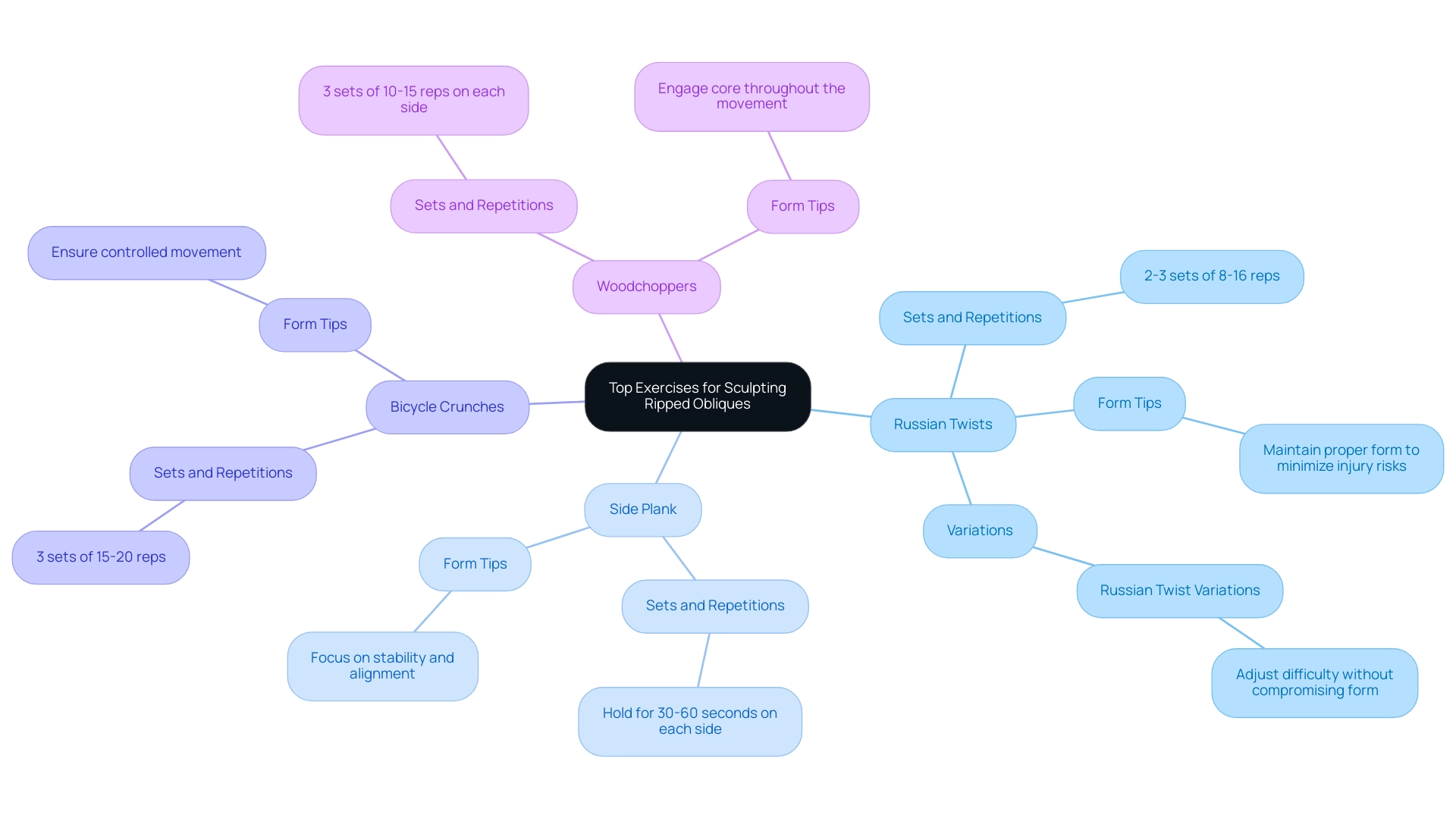
Avoiding Common Pitfalls in Oblique Training
- Neglecting Form: Prioritizing proper form over the number of repetitions is essential for effective and safe workouts. Poor technique can not only result in harm but also make your efforts ineffective. Take the time to master the correct posture for each exercise—your body will thank you for it. According to case studies, improper form is a significant factor in accident rates, with non-affiliated gyms showing a higher risk of occurrence.
- Overtraining: Consistency is essential in any fitness program, yet excessive strain on your side muscles can lead to fatigue and heightened risk of harm. Statistics show that 26% of diagnosed injuries were sprained ligaments, highlighting the importance of injury prevention. To prevent overtraining, ensure you allow adequate recovery time between workouts targeting these muscles. Remember, recovery is just as important as the workout itself.
- Ignoring Nutrition: Striving for well-defined side muscles goes beyond exercise; it requires a balanced diet. Consuming sufficient protein and healthy fats is crucial for supporting muscle growth and recovery. As a nutritionist emphasizes, a well-rounded diet is essential for achieving ripped obliques. This aligns with the understanding that proper nutrition plays a pivotal role in preventing harm and overall fitness.
- Focusing Solely on Obliques: Targeting the obliques is important, but neglecting other abdominal muscles can lead to imbalances and increase the risk of injury. Include a varied selection of fundamental activities to improve overall stability and strength. Balancing your workouts will not only improve performance but also contribute to a safer gym environment for everyone. As highlighted in recent findings, these changes are likely to have lasting effects on how gyms operate and engage with their members in the future.
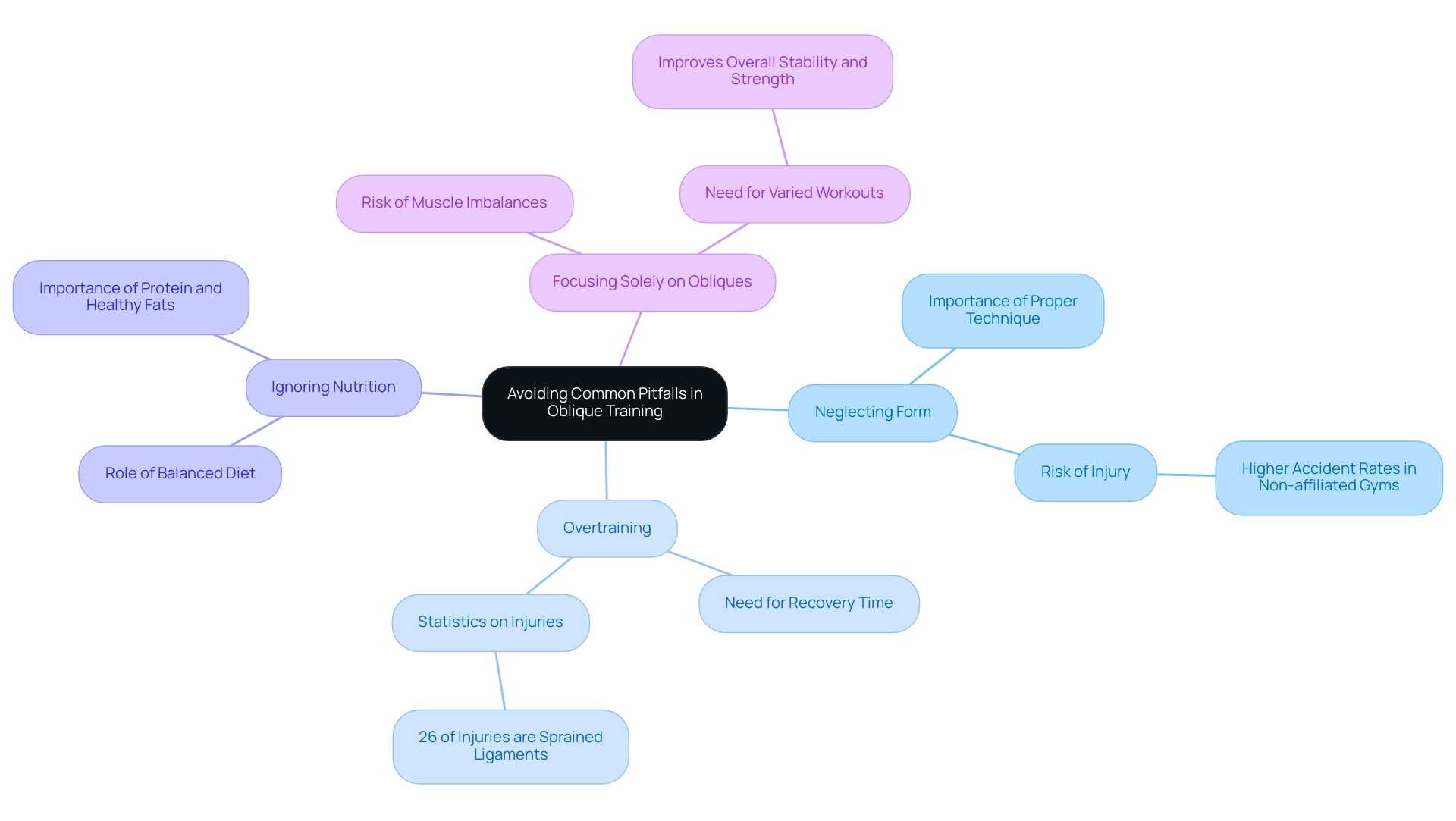
Integrating Strength and Flexibility for Optimal Results
To achieve optimal results in your fitness journey, it's crucial to integrate both strength and flexibility into your workout routine. Embracing activities such as yoga and Pilates can significantly enhance your range of motion and alleviate muscle tightness, making them invaluable components of any training regimen. Research shows that participants in Pilates and yoga programs experience not only improvements in physical metrics, such as the HSRS scores which improved from a pretest mean of 3.16 ± 0.711 to a post-test mean of 3.29 ± 0.356, but also in mental well-being, with findings indicating significant enhancements in quality of life and reductions in anxiety and depression levels among practitioners.
For example, a case study named 'Pilates and Aerobic Training Enhance Levels of Depression, Anxiety and Quality of Life in Overweight and Obese Individuals' concluded that both Pilates and aerobic training significantly improved levels of depression, anxiety, and overall quality of life.
Combining flexibility activities with focused strength training for the core muscles and ripped obliques will create a comprehensive approach. For example, after participating in angled exercises, consider incorporating stretches such as:
- The seated trunk twist
- Side bends
These stretches not only elongate the muscles but also promote flexibility, further enhancing your recovery.
This balanced approach will not only shape your ripped obliques but also enhance your overall physical performance. As noted by fitness experts, integrating both strength and flexibility is essential for injury prevention, with statistics highlighting that dedicated flexibility training can significantly reduce injury risk. Moreover, as Kim and Kim noted, yoga and meditation programs effectively alleviate depression among middle-aged women, positively influencing their social role performance and self-confidence.
So take the plunge, incorporate these practices into your routine, and watch as you transform not just your body, but also your approach to health and wellness. However, be cautious if you have hip problems, as certain movements may exacerbate discomfort.
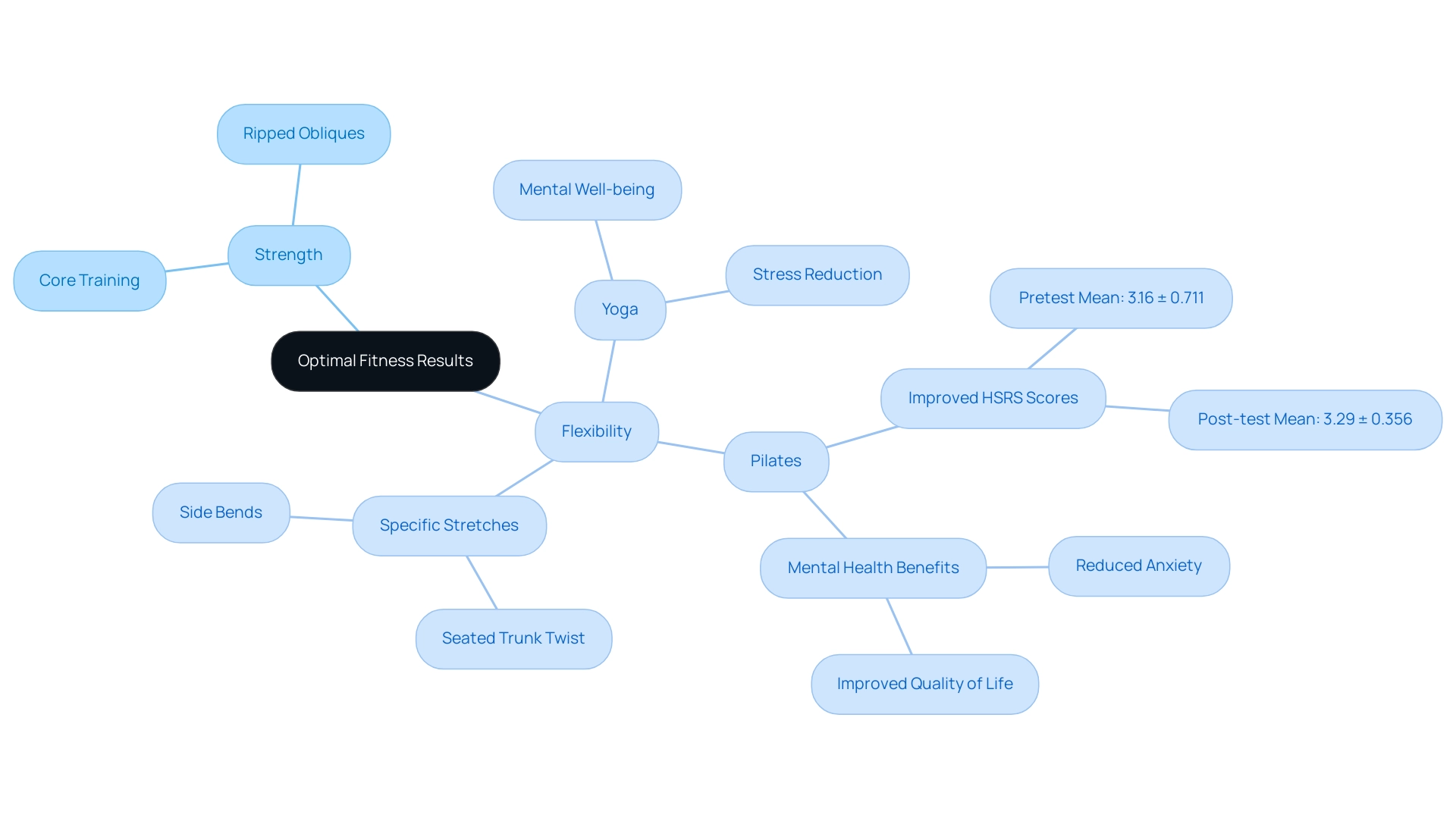
Creating a Comprehensive Oblique Workout Plan
Creating a comprehensive angled workout plan involves a thoughtful structure that drives both engagement and results:
- Frequency: Aim to train your side muscles 2-3 times per week. This recommendation aligns with recent findings that highlight a mean effect size of 0.77 for high-frequency routines, emphasizing the importance of optimal training frequency for maximizing outcomes. Ensure at least one day of rest between sessions to promote recovery and strength gains.
- Warm-Up: Initiate each workout with a 5-10 minute warm-up to prepare your body. Incorporate dynamic stretches or light cardio to enhance blood flow and minimize injury risk. This crucial step sets the stage for effective training and is often overlooked.
- Core Movements: Choose 3-5 focused activities for the side abdominal muscles, with a strong suggestion for High to Low Cable Woodchoppers. This activity effectively applies weighted resistance along the oblique fibers’ diagonal orientation, which is essential for optimal muscle development. Aim for 3 sets of 10-20 repetitions for each movement. As certified personal trainer Marshall Weber emphasizes, attention should be given to developing a functional center, not just an aesthetically pleasing one.
- Flexibility Training: Conclude your session with 10-15 minutes focused on flexibility exercises that target the core and side muscles. Incorporating stretches that promote elongation and relaxation is vital for recovery and overall performance.
- Progression: As your strength increases, gradually elevate the intensity of your workouts by adding weights or increasing repetitions. Tracking your progress is key to staying motivated and allows for necessary adjustments to your plan. By adhering to this structured approach, you're not just on a journey to achieving ripped obliques; you're also fostering a balanced and health-conscious fitness routine that emphasizes overall well-being.
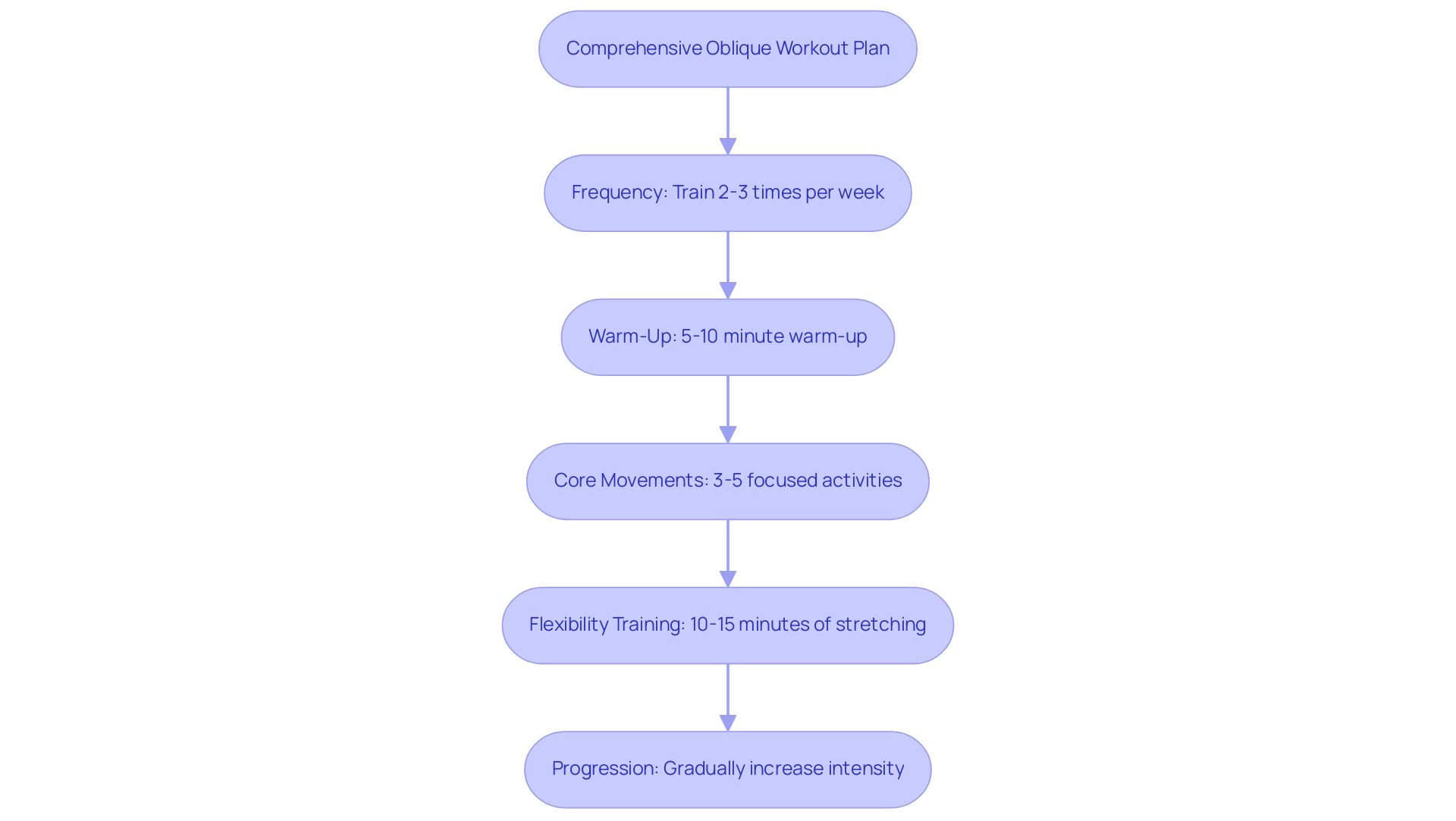
Conclusion
The significance of oblique muscles in achieving a healthier lifestyle and improved athletic performance is undeniable. By understanding their anatomy and function, organizations can effectively integrate targeted oblique workouts into their fitness initiatives. These exercises not only enhance core stability and functional movement but also play a critical role in injury prevention, ultimately fostering a resilient workforce.
Incorporating a variety of exercises such as:
- Russian twists
- Side planks
- Woodchoppers
can sculpt the obliques while improving overall core strength. However, it is essential to prioritize proper form, avoid overtraining, and maintain a balanced diet to maximize results and minimize injury risks. Furthermore, integrating flexibility training through practices like yoga and Pilates can enhance recovery and elevate physical performance.
Creating a comprehensive oblique workout plan that emphasizes:
- Frequency
- Warm-ups
- Core exercises
- Flexibility training
- Progression
is key to long-term success. By prioritizing these elements, organizations not only promote their team's well-being but also cultivate a culture of health that can lead to enhanced performance and reduced injury rates. Now is the time to take action and embrace the power of oblique training for a healthier, more robust workforce.
Frequently Asked Questions
What are the obliques and why are they important?
The obliques are the slanted muscles located on the sides of your abdomen. They are essential for core stability and functional movement, facilitating trunk rotation and lateral flexion, while also providing support to the spine.
How do strengthened obliques benefit athletic performance?
Strengthening the obliques enhances physical appearance, improves balance, and lowers the risk of accidents during sports and physical activities. Targeted training can enhance core stability and athletic performance.
What does recent research say about angled workouts for obliques?
Recent studies indicate that concentrating on angled workouts can significantly enhance core stability and help develop ripped obliques, leading to better athletic performance. For example, a study on Japanese baseball players showed that effective angled training helped them recover from strains.
What exercises can I do to strengthen my obliques?
Effective exercises include: 1. Russian Twists: Rotate your torso while sitting and engage your core. 2. Side Plank: Hold your body off the ground on your side to strengthen your midsection. 3. Bicycle Crunches: Alternate bringing your elbow to the opposite knee while lying on your back. 4. Woodchoppers: Rotate your torso while mimicking a chopping motion with a weight.
How many sets and repetitions should I do for these exercises?
Russian Twists: 2 to 3 sets of 8 to 16 repetitions. Side Plank: Hold for 30-60 seconds on each side. Bicycle Crunches: 3 sets of 15-20 repetitions. Woodchoppers: 3 sets of 10-15 repetitions on each side.
What should I keep in mind while performing these exercises?
It is important to maintain proper form to maximize results and minimize the risk of injury. Variations of these exercises can also be integrated to progressively improve abdominal strength.

